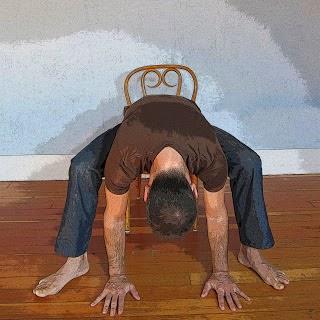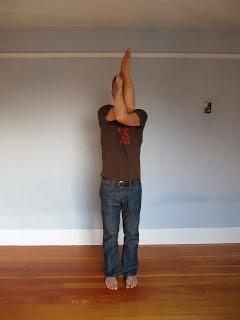 Flexibility is an invaluable quality for the upper body, when it is present! Our upper body, everything above the breathing diaphragm, needs to be mobile to bend, twist, arch, reach, and accomplish all the tasks that our upper limbs have evolved to do so well as we move around on two legs. In addition, our modern jobs tend to have us bound to a desk and computer station or our lives have us behind the wheel of a car for a good part of each day, activities which tend to encourage forward rounding of the upper back and chest. So a certain emphasis on back bending actions is helpful to balance out that tendency. Today’s sequence is designed with all that in mind.
Flexibility is an invaluable quality for the upper body, when it is present! Our upper body, everything above the breathing diaphragm, needs to be mobile to bend, twist, arch, reach, and accomplish all the tasks that our upper limbs have evolved to do so well as we move around on two legs. In addition, our modern jobs tend to have us bound to a desk and computer station or our lives have us behind the wheel of a car for a good part of each day, activities which tend to encourage forward rounding of the upper back and chest. So a certain emphasis on back bending actions is helpful to balance out that tendency. Today’s sequence is designed with all that in mind.Upper Body Flexibility Sequence
1. Passive Backbend over Blocks: Sit on your mat and position two blocks behind you. Place one on its lowest height, positioned crosswise, like a bra strap, so that when you lie down, it will be under your shoulder blades. Place the second block about six inches behind the first block, positioned lengthwise like your spine, on its middle height. Now lie back over the two blocks, with the first block under your heart area and the lower tips of your shoulder blades touching the middle of the block. Rest your head on the second block, so your head is slightly elevated. Stretch your legs long on your mat, with your buttocks resting on the floor, and a bit of energy in the legs. Take your arms straight out to your sides and energetically reach from the center of your chest into your fingers, allowing the back of your hands to rest on the floor, but elbows off the floor. This variation encourages opening across the front of the chest. Stay here breathing comfortably for 30-60 seconds.
Next, reach your arms skyward, with your palms facing one another, really reaching up as high as you can. Keeping some strength in your legs, begin to bring your arms overhead until your arms line up with your ears, if your shoulders permit. Press forward with your heels and reach backwards with your hands. This variation starts to open your shoulder joints and the front length of your upper chest. It is more demanding than the first variation, so start with shorter holds, such as 15-30 seconds. To come out, exhale your arms down to your sides, bend your knees and roll gently to one side, sitting up and moving your blocks to one side.
2. Bridge Pose (Setu Bandha): From Constructive Rest position (on your back with knees bent and heels about four inches from your hips), establish the normal, slightly arched shape of your lumbar spine. Then lift your hips straight up as you push down into your feet, like an elevator going up a few floors, maintaining the neutral arch of the lower back. Once in Bridge pose, bring some focus to your arms. Press the upper back of your upper arms (right where your arms meets the shoulders) down into the floor firmly while actively lifting the lower tip of your breast bone up to the sky. Then press your arms, which are lengthening towards your feet, down firmly into the floor as well. This will begin to encourage extension of your shoulder joints. Stay for 15-30 seconds. To come down, lower your hips straight down, like an elevator returning to the lobby floor. Rest for a moment and consider repeating one more time.
3. Downward Facing Dog (Adho Muka Svanasana): From hands and knees position, come up into Downward-Facing Dog pose. See Downward-Facing Dog Variations for variations you can use to experience the upper body stretching of this versatile pose. Try any or all to find the variation that is right for you! I especially like classic, full Downward-Facing Dog pose. This pose has a similar effect to our reclining backbend with the arms overhead, opening the shoulder into what is known anatomically as “flexion” of the joint.
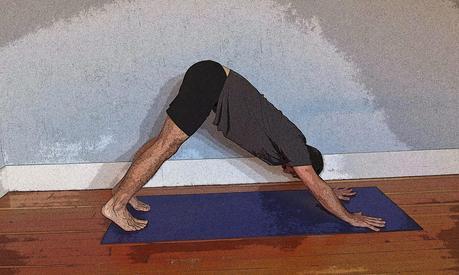
4. New Moon Pose (Urdhva Hastasana variation): From Mountain Pose, inhale your arms overhead in line with your ears. Keeping your legs strongly engaged, side bend a few inches to your right, like the shape of a new crescent moon. Keeping your arms parallel to each other and your head and neck evenly between them, reach actively up along the line of the curves of your spine. Focus on opening your rib cage on your left side. Start with just a four to six breaths before coming back to center and tipping to the other side. To come out, simply lower your arms to your sides on an exhalation. You can repeat a second time.
5. Cow-Face Pose Arms (Gomukasana): This versatile pose uses just the arm position from the full Cow-Face pose, which is typically done in a seated position. Because the pose works your two arms differently, it’s almost like two poses in one, taking your shoulders and arms through much of their range of motion. With your top arm, you reach up and overhead, spinning your upper arm bone outward and deeply bending your elbow joint. With your bottom arm, you reach down and back behind you, spinning your upper arm bone inward as you bend at the elbow joint. As it works your arms, this pose also stretches and strengthens your shoulder blades, upper back and neck. See Standing Cow-Face Pose for complete information.
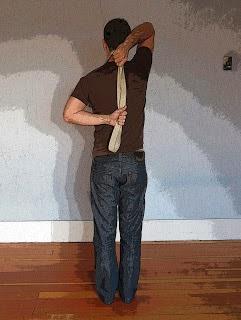

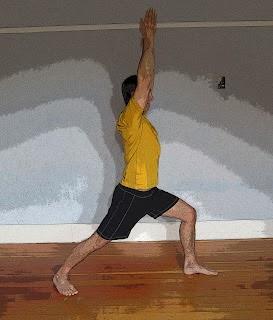
9. Modified Camel (Ustrasana): Place a chair against a wall, with the seat facing the center of the room. Kneel down in front of the chair facing away from the wall, with your feet just under the front edge of the chair (place a blanket under your knees if needed). Start with your hands on your hips and pressing your shinbones firmly down, lengthen up from the floor to the crown of your head, beginning to take a slight backbend shape. One hand at a time, reach back and find the front edge of the chair seat, and keeping the arms straight and using them to support the lift an openness of your front chest, arch into Camel pose for 15-30 seconds. You may want to keep your chin tucked slightly towards your chest if your neck is sensitive when dropping backwards, or you can try taking your head and neck into a slight backbend, too. On an exhalation, bring your hand to hips and your spine to neutral kneeling position.
If you regularly practice full Camel pose, feel free to practice that version instead.
10. Child’s Pose (Balasana): Repeat Child's Pose here for one to two minutes as a nice counterpose to Camel pose.
11. Chair Seated Forward Bend: Since you have your chair out from doing Camel pose, follow Child’s Pose with this seated version of a gentle forward bend to bring more flexibility to the back upper body.
